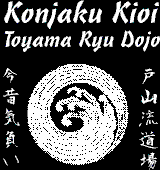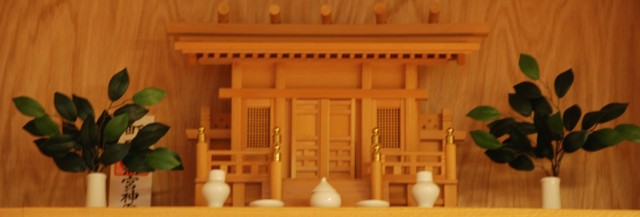 |
Toyama Ryu Batto Do Konjaku Kioi Dojo (Ancient and Modern Fighting Spirit Dojo) |
5980 66th St N Suite M St Petersburg FL 33709 Email: info@toyama-ryu.com Phone: 727-329-9679 |
|
Home
|
Bow Out CeremonyThe bow-in and bow-out ceremonies are an essential part of the class in the Konjaku Kioi Toyama Ryu Dojo. They mark the beginning an end of training and help the student transition into the proper frame of mind for training. Unlike most iaido schools, our bow-in/out ceremony is done standing.
Set-Up For The Bow-Out CeremonyThe loose end of the sageo cord is pulled to disengage the knot on the hakama straps. The sageo (saya cord) is grasped 2/3 down from the kurikata (knob on the saya where the sageo is tied) between the index and pointer fingers of the right hand. The katana is grasped by the saya (scabbard) in the right hand with the thumb holding the tsuba (guard) in place. The katana are then removed from the obi and held at the right side with the ha (edge) up. The instructor stands in front of the kamidana (Shinto Shrine signifying the heart of the dojo) and students line up facing them. Students should stand in order of seniority with the highest farthest from the dojo entrance. If multiple lines are needed the most senior students are in the front row. Student should line up with their senior and everyone should be evenly spaced. Call To AttentionThe instructor calls the students to attention with the command “KIOTSUKE”. The arms are held at the sides with the katana still in the right hand. The left hand should be held with fingers and thumb straight and together resting lightly on the thigh. Feet are angled slightly outward with the heels together. The knees are slightly bent and the back is straight. The head is held up with the shoulders down. Bow To Your KatanaThe first bow is to the katana. The instructor announces ”TORII”. The right hand is brought forward and up to the center and the ha should face backwards. The katana should rest on the left hand. The katana is rotated to horizontal position at eye level. The tsuba is held between the index and pointer fingers of the right hand. The saya kojiri (end cap) is held securely with the pointing finger of the left hand. The ha (edge) should face backwards. The instructor calls for the bow by announcing “REI”. This bow is the not a deep or long as the others. The bow is about 15 degrees and should last about 1 second. The back and neck should be kept straight. Do not bend your neck down or arch your back and keep your eyes looking forward. Bow To KamidanaThe instructor turns to the kamidana (Shinto Shrine signifying the heart of the dojo) or an appropriate substitute. Following the instructor, katana are changed to a more respectful position. The right hand is brought forward and the left hand grasps the saya about six inches below the right hand. The right hand releases the saya but keeps the sageo between the fingers. The katana is tilted back with the left hand reversing the blade and the saya is again grasped with the right hand. The ha (edge) should be down and the tsuka (handle) should face forward. The left hand should be returned to the left side. The instructor says the command “SHINZEN NI – REI” and everyone takes a long deep bow towards the kamidana. This is the lowest and longest of the three bows. The back and neck should be kept straight. Do not bend your neck down or arch your back. The back should be about 45 degrees and the bow should last about 3 seconds. The instructor then leads the class in returning their katana to the normal position. The left hand grasps the saya about six inches below the right hand. The right hand releases the saya but keeps the sageo between the fingers. The katana is tilted forward with the left hand reversing the blade and the saya is again grasped with the right hand. The ha (edge) should be up and the tsuka (handle) should face to the rear. The left hand should be returned to the left side. The instructor turns to face the class once more. Bow To The Class / InstructorThe final bow is between the students and the instructor. The instructor calls for the bow saying ”OTOGAI NI – REI”. This bow should only be about 30 degrees and the eyes should remain looking forward. The back and neck should be kept straight. Do not bend your neck down or arch your back. The class should respond “DOMO ARIGOTOU GOZAIMASHITA” during the bow. This is a thank you for being instructed. The bow should last about 2 seconds. |
Copyright © 2006 by Konjaku Kioi Toyama Ryu Dojo, All rights reserved.
Samurai Swords
Iaito (Practice Swords)
Shinken (Cutting Swords)
Wakizashi (Short Swords)
Tanto (Daggers)
Japanese Weapons
Maintenance
Uniforms
Sharpening
Sword Repair
Martial Arts
Dictionary Your Name in Japanese
Dojo Stories
Tatami Targets

